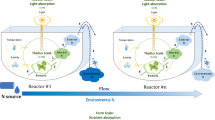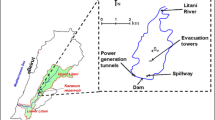Abstract
A dynamical model for simulating growth of the brown macroalga Saccharina latissima is described. In addition to wet and dry weights, the model simulates carbon and nitrogen reserves, with variable C/N ratio. In effect, the model can be used to emulate seasonal changes in growth and composition of the alga. Simulation results based on published, environmental field data are presented and compared with corresponding data on growth and composition. The model resolves seasonal growth, carbon and nitrogen content well, and may contribute to the understanding of how seasonal growth in S. latissima depends simultaneously on a combination of several environmental factors: light, nutrients, temperature and water motion. The model is applied to aquaculture problems such as estimating the nutrient scavenging potential of S. latissima and estimating the potential of this kelp species as a raw material for bioenergy production.







Similar content being viewed by others
References
Abreu H, Varela DA, Henríquez L, Villaroel A, Yarish C, Sousa-Pinto I, Buschmann AH (2009) Traditional vs. integrated aquaculture of Gracilaria chilensis C. In: Bird J, McLachlan J, Oliveira EC (eds) Productivity and physiological performance. Aquaculture 293:211–220
Adams JM, Gallagher JA, Donnison IA (2009) Fermentation study on Saccharina latissima for bioethanol production considering variable pre-treatments. J Appl Phycol 21:569–574
Adams RA (2007) Calculus: a complete course. Pearson Education, Paris
Ahn O, Petrell RJ, Harrison PJ (1998) Ammonium and nitrate uptake by Laminaria saccharina and Nereocystis luetkeana originating from a salmon sea cage farm. J Appl Phycol 10:333–340
Atkinson MJ, Smith SV (1983) C:N:P ratios of benthic marine plants. Limnol Oceanogr 28:568–574
Aveytua-Alcázar L, Camacho-Ibar VF, Souza AL, Allen JI, Torres R (2008) Modelling Zoestra marina and Ulva spp. in a coastal lagoon. Ecol Model 218:354–366
Baird ME, Middleton JH (2004) On relating physical limits to the carbon: nitrogen ratio of unicellular algae and benthic plants. J Mar Syst 49:169–175
Bartsch I, Wiencke C, Bischof K, Buchholz CM, Buck BH, Eggert A, Feuerpfeil P, Hanelt D, Jacobsen S, Karez R, Karsten U, Molis M, Roleda MY, Schubert H, Schumann R, Valentin K, Weinberger F, Wiese J (2008) The genus Laminaria sensu lato: recent insights and developments. Eur J Phycol 43:1–86
Black WAP (1950) The seasonal variation in weight and chemical composition of the common British Laminariaceae. J Mar Biol Ass UK 19:45–72
Bolton JJ, Lüning K (1982) Optimal growth and maximal survival temperatures of Atlantic Laminaria species (phaeophyta) in culture. Mar Biol 66:89–94
Brinkhuis BH, Mariani EC, Breda VA, Brady-Campbell MM (1984) Cultivation of Laminaria saccharina in the New York Marine Biomass Program. Hydrobiologia 116/117:266–271
Buck BH, Buchholz CM (2005) Response of offshore cultivated Laminaria saccharina to hydrodynamic forcing in the North Sea. Aquaculture 250:674–691
Chapman ARO, Markham JW, Lüning K (1978) Effects of nitrate concentration on the growth and physiology of Laminaria saccharina (phaeophyta) in culture. J Phycol 14:195–198
Davison IR (1987) Adaption of photosynthesis in Laminaria saccharina (phaeophyta) to changes in growth temperature. J Phycol 23:273–283
Dring MJ (1992) The biology of marine plants. Cambridge University Press, Cambridge
Droop MR (1983) 25 years of algal growth kinetics—a personal view. Bot Mar 26:99–112
Droop MR, Mickleson JM, Scott JM, Turner MF (1982) Light and nutrient status of algal cells. J Mar Biol Ass UK 62:403–434
Duarte P, Ferreira JG (1993) A methodology for parameter estimation in seaweed productivity modelling. Hydrobiologia 260/261:183–189
Duarte P, Ferreira JG (1997) A model for the simulation of macroalgal population dynamics and productivity. Ecol Model 98:199–214
Duarte P, Meneses R, Hawkins AJS, Zhu M, Fang J, Grant J (2003) Mathematical modelling to assess the carrying capacity for multi-species culture within coastal waters. Ecol Model 168:109–143
Espinoza J, Chapman ARO (1983) Ecotypic differentiation of Laminaria longicruris in relation to seawater nitrate concentration. Mar Biol 74:213–218
Fortes MD, Lüning K (1980) Growth rates of North Sea macroalgae in relation to temperature, irradiance and photoperiod. Helgol Wiss Meeresunters 34:15–29
Gagné JJ, Mann KH, Chapman ARO (1982) Seasonal patterns of growth and storage in Laminaria longicruris in relation to differing patterns of availability of nitrogen in the water. Mar Biol 69:91–101
Gerard V (1988) Ecotypic differentiation in light-related traits of the kelp Laminaria saccharina. Mar Biol 97:25–36
Gerard VA (1987) Hydrodynamic streamlining of Laminaria saccharina Lamour. In response to mechanical stress. J Exp Mar Biol Ecol 107:237–244
Gerard VA, DuBois K, Greene R (1987) Growth responses of two Laminaria saccharina populations to environmental variation. Hydrobiologia 151/152:229–232
Harrison PJ, Hurd CL (2001) Nutrient physiology of seaweeds: application of concepts to aquaculture. Cah Biol Mar 42:71–82
Hatcher BG, Chapman ARO, Mann KH (1977) An annual carbon budget for the kelp Laminaria longicruris. Mar Biol 44:85–96
Haug A, Jensen A (1954) Seasonal variations in the chemical composition of Alaria esculenta, Laminaria saccharina, Laminaria hyperborea and Laminaria digitata from Northern Norway. Tech. Rep. 4, Norwegian Institute of Seaweed Research
Holling CS (1959) Some characteristics of simple types of predation and parasitism. Can Entomol 91:385–398
Hurd CL, Harrison PJ, Druehl LD (1996) Effect of seawater velocity on inorganic nitrogen uptake by morphologically distinct forms of Macrocystis integrifolia from wave-sheltered and exposed sites. Mar Biol 126:205–214
Iserles A (1996) A first course in the numerical analysis of differential equations. Cambridge University Press, Cambridge
Jackson GA (1987) Modelling the growth and harvest yield of the giant kelp Macrocystis pyrifera. Mar Biol 95:611–624
Jørgensen SE, Bendoricchio G (2001) Fundamentals of ecological modelling, 3rd edn. Elsevier, Amsterdam
Joska MAP, Bolton JJ (1987) In situ measurement of zoospore release and seasonality of reproduction in Ecklonia maxima (Alariaceae, Laminariales). Br Phycol J 22:209–214
Kain JM (1989) The seasons in the subtidal. Br Phycol J 24:203–215
Kawamata S (2001) Adaptive mechanical tolerance and dislodgement veolcity of the kelp Laminaria japonica in wave-induced water motion. Mar Ecol Prog Ser 211:89–104
Kooijman SALM (2000) Dynamic energy and mass budgets in biological systems, 2nd edn. Cambridge University Press, Cambridge
Lobban CS, Harrison PJ (1994) Seaweed ecology and physiology. Cambridge University Press, Cambridge
Lüning K (1979) Growth strategies of three Laminaria species (phaeophycea) inhabiting different depth zones in the sublittoral region of Helgoland (North Sea). Mar Ecol Prog Ser 1:195–207
Lüning K (1990) Seaweeds: their environment, biogeography, and ecophysiology. Wiley, New York
Lüning K (1993) Environmental and internal control of seasonal growth in seaweeds. Hydrobiologia 260/261:1–14
Lüning K, Dring MJ (1985) Action spectra and spectral quantum yield of photosynthesis in marine macroalgae with thin and thick thalli. Mar Biol 87:119–129
Mann KH (2000) Ecology of coastal waters. With implications for management. Blackwell Science, Oxford
Martinez LA, Buschmann AH (1996) Agar yield and quality of Gracilaria chilensis (Gigartinales, Rhodophyta) in tank culture using fish effluents. Hydrobiologia 326/327:341–345
Martins I, Lopes RJ, Lillebø AI, Neto JM, Pardal MA, Ferreira JG, Marques JC (2007) Siginificant variations in the productivity of green macroalgae in a mesotidal estuary: implications to the nutrient loading of the system and the adjacent coastal area. Mar Pollut Bull 54:678–690
McDevit DC, Saunders GW (2010) A DNA barcode examination of the laminariaceae (phaeophyceae) in Canada reveals novel biogeographical and evolutionary insights. Phycologia 49:235–248
Neish AC, Shacklock PF, Fox CH, Simpson FJ (1977) The cultivation of Chondrus crispus. Factors affecting growth under greenhouse conditions. Can J Bot 55:2263–71
Olsen LM, Holmer M, Olsen Y (2008) Perspectives of nutrient emission from fish aquaculture in coastal waters. Final report, The Fishery and Aquaculture Industry Research Fund
Petrell RJ, Alie SY (1996) Integrated cultivation of salmonids and seaweeds in open systems. Hydrobiologia 326/327:67–73
Petrell RJ, Tabrizi KM, Harrison PJ, Druehl LD (1993) Mathematical model of Laminaria production near at British Columbian salmon sea cage farm. J Appl Phycol 5:1–14
Platt T, Gallegos CL, Harrison WG (1980) Photoinhibition of photosynthesis in natural assemblages of marine phytoplankton. J Mar Res 38:687–701
Rueness J, Fredriksen S (1991) An assessment of possbile pollution effects on benthic algae of the outer Oslofjord, Norway. Oebelia 17(suppl.):223–235
Sakshaug E, Johnsen G, Kovacs K (eds) (2009) Ecosystem Barents Sea. Academic, Tapir
Sanderson JC (2009) Bioremediation using seaweed culture. VDM Verlag Dr. Müller, Düsseldorf
Schaffelke B (1995) Storage carbohydrates and abscisic acid contents in Laminaria hyperborea. Eur J Phycol 30:313–317
Schaffelke B, Lüning K (1994) A circannual rhythm controls seasonal growth in the kelps Laminaria hyperborea and L. digitata from Helgoland (north sea). Eur J Phycol 29:49–56
Sjøtun K (1993) Seasonal Lamina Growth in two Age groups of Laminaria saccharina (L.) Lamour. in Western Norway. Botanica Marina 36:433–441
Sjøtun K (1995) Adaptive aspects of growth and reproduction in two north atlantic Laminaria species. Ph.D. thesis, University of Bergen
Sjøtun K, Gunnarsson K (1995) Seasonal growth pattern of an Icelandic Laminaria population (section Simplices, Laminariaceae, Phaeophyta) containing solid- and hollow-stiped plants. Eur J Phycol 30:281–287
Sjøtun K, Fredriksen S, Rueness J (1996) Seasonal growth and carbon and nitrogen content in canopy and first-year plants of Laminaria hyperborea (laminariales, phaeophyceae). Phycologia 35:1–8
Solidoro C, Pecenik G, Pastres R, Franco D, Dejak C (1997) Modelling macroalgae Ulva rigida in the Venice lagoon: model structure identification and first parameters estimation. Ecol Model 94:191–206
Stevens C, Hurd C, Isachsen PE (2003) Modelling of diffusion boundary-layers in subtidal macroalgal canopies: the response to waves and currents. Aquat Sci 65:81–91
Subandar A, Petrell RJ, Harrison PJ (1993) Laminaria culture for reduction of dissolved inorganic nitrogen in salmon farm effluent. J Appl Phycol 5:455–463
Sundene O (1953) The algal vegatation of Oslofjord. Skrifter utgitt av Det Norske Vitenskaps-Akademi i Oslo. I Matematisk-naturvidenskapelig klasse, Det Norske Vitenskaps-Akademi
Trancoso AR, Saraiva S, Fernandes L, Nina P, Leitao P, Neves R (2005) Modelling macroalgae using a 3D hydrodynamic-ecological model in a shallow, temperate estuary. Ecol Model 187:232–246
Troell M, Joyce A, Chopin T, Neori A, Buschmann AH, Fang JG (2009) Ecological engineering in aquaculture—potential for integrated multi-trophic aquaculture (IMTA) in marine offshore systems. Aquaculture 297:1–9
Wassmann P, Slagstad D, Riser CW, Reigstad M (2006) Modelling the ecosystem dynamics of the Barents Sea including the marginal ice zone II. Carbon flux and interannual variability. J Mar Syst 59:1–24
Acknowledgements
The authors wish to thank K. Sjøtun for information about sampling dates and K. Sjøtun and Walter de Gruyter GmbH for granting permission to replot the data in Figs. 2a and 3b–d. They also thank M.O. Alver, M.J. Dring, I.H. Ellingsen, S. Forbord, K.I. Reitan and T. Størseth for valuable discussions and comments on the model and earlier versions of the manuscript. Two anonymous referees contributed several remarks that helped in improving the paper.
Author information
Authors and Affiliations
Corresponding author
Additional information
This work was supported by the Norwegian Research Council project number 173527, “Integrated open seawater aquaculture, technology for sustainable culture of high productive areas”.
Rights and permissions
About this article
Cite this article
Broch, O.J., Slagstad, D. Modelling seasonal growth and composition of the kelp Saccharina latissima . J Appl Phycol 24, 759–776 (2012). https://doi.org/10.1007/s10811-011-9695-y
Received:
Accepted:
Published:
Issue Date:
DOI: https://doi.org/10.1007/s10811-011-9695-y




